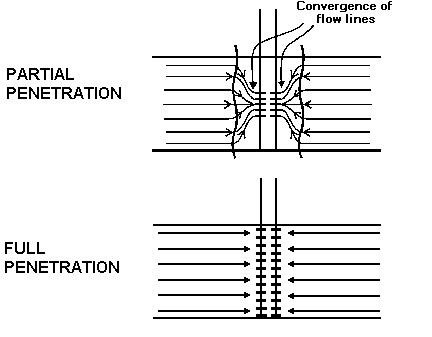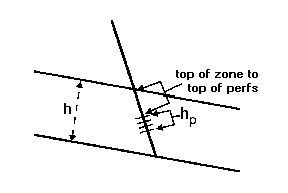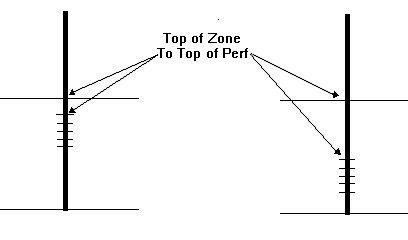Partial Penetration
Subtopics:
Top of Zone to Top of Perforations
Horizontal To Vertical Permeability Ratio
When a well does not fully penetrate the formation, or the perforations do not open up the whole formation, the reservoir fluid has to flow vertically with the flow lines converging near the penetrated area at the wellbore. The diagram below shows the flow pattern differences between full and partial penetration.

The convergence of the flow lines near the wellbore cause an additional pressure drop near the wellbore, an effect similar to that caused by wellbore damage. In some cases, when the penetrated region is very small compared to the formation thickness or net pay (h), spherical flow may be observed. The effects of partial penetration are accounted for by treating it as a skin effect called skin due to partial penetration (spp). This skin is always positive and typically varies from 0 to 30. It is a function of the height of the perforated interval (hp), the distance from the top of the zone to the top of the perforations (htop), and the horizontal to vertical permeability ratio (kh/kv).
Height of Perforations (hp)
The height of perforations or perforated interval is that portion of the net pay (h) that is open to flow into the wellbore either through partial penetration of the wellbore, or incomplete perforation.
Normally, in order to maximize production, the entire net pay (h) is open to flow into the wellbore (fully penetrated, hp = h). In some cases, it is necessary to perforate so only a portion of the net pay (h) is open to the wellbore in order to minimize coning effects. This perforated interval is judiciously placed a certain distance from the top of the zone to the top of the perforations (htop). If the wellbore is inclined, the perforated interval is measured along the inclination as illustrated below.

The perforated interval has a maximum value dependent on the net pay (h) and the net wellbore inclination (s).
Top of Zone to Top of Perforations (htop)
In a partially penetrated well, this is the distance from the top of the zone to the top of perforations as shown in the diagram below. For an inclined wellbore, it is the distance measured along or parallel to the wellbore. The maximum value of this distance is related to the net pay (h), the net wellbore inclination (s), and the height of perforations (hp).

When a formation is only partially penetrated, the location of the perforated interval has an effect on the skin due to partial penetration (spp). Thus the diagrams below show the same net pay (h) and the same perforated intervals, but because these perforated intervals are located at different locations they will have different skin effects due to partial penetration.

Horizontal To Vertical Permeability Ratio (kh / kv)
The horizontal-to-vertical permeability ratio represents the contrast in permeability between the horizontal and vertical planes within a formation (anisotropic permeability). This ratio is applicable when dealing with partially penetrated or horizontal wells and directly affects the skin due to partial penetration (spp). It typically ranges in value from 0.1 to 1000.
For example, in a well with partial penetration the fluid has to travel vertically because the whole of the net pay (h) is not open to the wellbore as shown below.

This vertical component of flow calls into play the vertical permeability, in addition to the horizontal permeability.
A large horizontal-to-vertical permeability ratio implies a relatively low vertical permeability, which creates a larger pressure drop near the wellbore due to the vertical component of flow. Thus, this increase in pressure drop near the wellbore is represented as an increase in the skin due to partial penetration (spp).